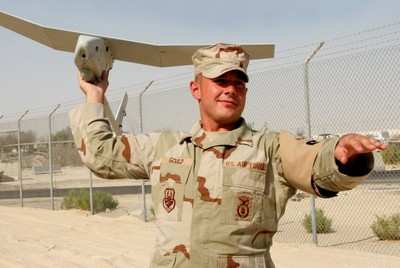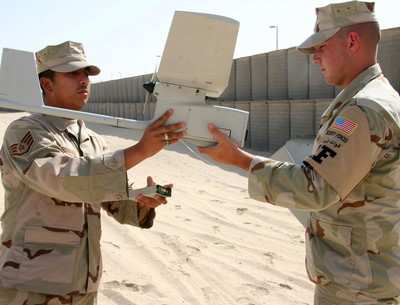Raven B Has Landed in Southwest Asia
 A small unmanned aerial
vehicle is now being used to increase the 380th Air Expeditionary
Wing's force protection capabilities. Maintained and operated by
the 380th Expeditionary Security Forces Squadron, the Raven B is
the wing's sixth and smallest aircraft, weighing 4.2 pounds with a
wing span of 65 inches and a length of 35 inches. It is used by
security forces Airmen for reconnaissance and surveillance, force
protection, battle damage assessment and convoy security missions.
It has the capability to take still photos or live video from the
time of launch to the time of recovery.
A small unmanned aerial
vehicle is now being used to increase the 380th Air Expeditionary
Wing's force protection capabilities. Maintained and operated by
the 380th Expeditionary Security Forces Squadron, the Raven B is
the wing's sixth and smallest aircraft, weighing 4.2 pounds with a
wing span of 65 inches and a length of 35 inches. It is used by
security forces Airmen for reconnaissance and surveillance, force
protection, battle damage assessment and convoy security missions.
It has the capability to take still photos or live video from the
time of launch to the time of recovery.
"Initially it will be used here to get eyes on the area where
the enemy could launch a man-portable air-defense systems
surface-to-air missile or other weapon at the aircraft or runway,"
said 1st Lt. Daryl Crosby, the 380th ESFS Force Protection Airborne
Surveillance System program, officer in charge.
"With this airframe we can increase our force protection through
aerial monitoring of the (surface-to-air missile) footprint."
"The FPASS program isn't new to security forces, however the
Raven B is, and its capabilities far exceed the previous air frame,
the Desert Hawk," Lieutenant Crosby said. "The Army has been using
this airframe in the (area of responsibility), and now the Air
Force has adopted the technology."
"It allows you to see targets or threats before we send out
patrols or convoys to a particular location," said Staff Sgt. Karlo
Arenivas, the 380th ESFS FPASS NCO in charge. "It's pretty
incredible to know what's on the other side of the hill before you
go over it. The SUAV allows you a beyond line-of-sight view of the
battlefield."
The Raven B has unlimited launching capabilities. It can be
launched from moving vehicles, roof tops, or any open area. It can
be deployed in a backpack to be jumped or marched into combat. The
system is designed to be set up and launched in minutes. The SUAV
is designed to break apart on impact, minimizing damage by
distributing the impact energy.
The SUAV has two modes of operation. Vehicle operators can
remotely control the aircraft from a handset, just like a pilot
controls a regular aircraft, or it can be controlled in navigation
mode where the desired mission specifications are preloaded and the
vehicle flies a mission on its own.
"During a (remotely controlled) mission the vehicle operator is
concentrating on his video feed to determine where the aircraft is
flying in relation to the grid points entered into the system,"
Sergeant Arenivas said.

"On the laptop you'll have detailed maps of the area the SUAV is
flying in and another pull down screen with live video feed."
When the aircraft is flying the mission operator is monitoring
the video feed and taking still photos.
In navigation mode, the mission operator pre-loads the Raven B
with the desired altitude, flight path and time for it to take live
video. The Raven B is launched by the mission controller and flies
the rest of the mission on its own, sending telemetry back to
mission control and enabling end-product users to track the
location and field of view through a graphical interface.
The mission operator monitors the distance, range and bearing of
the aircraft during the mission, and keeps a close eye on the
battery life to make sure the aircraft can get where it needs to go
and back.
There are three different systems connected to the Raven B that
receive the live video feed. This video is displayed on screens
monitored by the mission operator and vehicle operator.
The Raven B is a good tool for convoy security because the
aircraft can be operated while the convoy is moving and get real
time video providing an eye in the sky, recording and alerting the
convoy to threats or anything suspicious in the areas ahead.
Another unique capability of the Raven B is that the photos it
captures can be used as a measuring tool.
"We can take these photos when we see an area of interest and
use the range and bearing tool to measure the distance between two
objects," Airman Gould said. "When you're out on patrol you can
take a picture and then put two way points on objects, say a
building and vehicle in the picture. Then you can calculate the
actual distance between the two objects."
This ability aids in the up channeling of target data, ensuring
very specific and detailed information is delivered to leadership
about areas of interest or concern.
"It can actually give you detailed coordinates for target
identification and target location," Airmen Gould said. "If
security forces are about 300 meters away from a target to engage,
the Raven B can fly ahead to help ground troops get eyes on areas
of vulnerability and engage the correct target. It can also take
two unknown areas and develop range and grid coordinates for an
area of interest or potential targets. Ground troops can also plot
their targets from the information gained from the Raven B."
The live video feed can also be sent to other locations.

"The system can be linked wirelessly to your Base Defense
Operation Center," Lieutenant Crosby said. "Commanders, operations
officers and base leaders can get real-time video feed to make
split second decisions. Pictures and video taken by the Raven B can
also be recorded to DVD, or sent via e-mail."
The Raven B also has in-flight emergency procedures.
"If the aircraft stops sending signal or we lose signal with the
aircraft, it will automatically switch into 'home mode'. Then Raven
B will automatically return to where it was launched or a
pre-designated location in case your unit is on the move," Sergeant
Arenivas said.
"It also has a 'Falcon Tracker' which is a small disc with an
eight-inch antenna on it that is attached to the tail of the
aircraft," Airman Gould said. "If the aircraft goes down, the
Falcon Tracker puts a signal out to help track and retrieve
it."
"I think it's pretty exciting to be selected to be part of a new
Air Force SUAV program," Airman Gould said. "I am looking forward
to flying it and seeing just what its capabilities are and how it
will impact the mission here."
"I have experience with the FPASS program from when we used the
Desert Hawk air frame," Lieutenant Crosby said. "I am very pleased
to see the Raven B employed in the AOR because it is leaps and
bounds ahead of the technology that we had before. The capabilities
are great. The Raven B is a legitimate SUAV, and it's a great force
protection tool." [ANN Thanks Master Sgt. Ruby Zarzyczny, 380th Air
Expeditionary Wing Public Affairs]
 True Blue Power and Mid-Continent Instruments and Avionics Power NBAA25 Coverage
True Blue Power and Mid-Continent Instruments and Avionics Power NBAA25 Coverage ANN's Daily Aero-Term (10.15.25): En Route Automation System (EAS)
ANN's Daily Aero-Term (10.15.25): En Route Automation System (EAS) Aero-News: Quote of the Day (10.15.25)
Aero-News: Quote of the Day (10.15.25) ANN's Daily Aero-Linx (10.15.25)
ANN's Daily Aero-Linx (10.15.25) NTSB Final Report: Jeremy S Lezin Just SuperSTOL
NTSB Final Report: Jeremy S Lezin Just SuperSTOL





